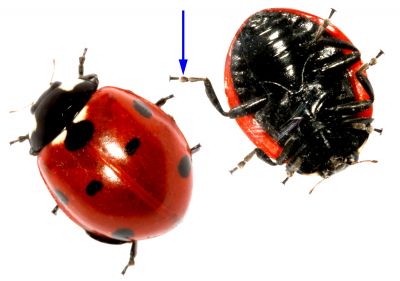Ladybirds in rubber boots
Scientists from Kiel University study ladybirds’ feet
During their evolution, insects have developed various unique features
to survive in their environment. The knowledge of the working principles
of insects’ microstructures holds great potential for the development
of new materials, which could be of use to humans. With this idea in
mind, Dr. Jan Michels, a scientist at the Institute of Zoology at Kiel
University, investigates how insects manage to efficiently cling to
diverse surfaces. Michels and his colleagues recently published their
new findings on the adhesive structures of ladybirds in the scientific
journal Nature Communications.
A lot of insects are able to climb up walls or walk upside down on
surfaces. The new study shows for the first time what astonishing
materials allow for these abilities. Using special microscopy
techniques, confocal laser scanning microscopy and atomic force
microscopy, Michels and his colleagues investigated the legs of
ladybirds. “Each leg is equipped with many fine adhesive setae, which
enable the insect to cling to surfaces in a most impressive way”,
explains Michels. “Our results show that different parts of these setae
feature varying material compositions and properties. While the bases
are relatively hard and stiff, the material in the tips of the setae is
rather soft and flexible.” The scientists assume that this enables the
tips to adjust to uneven surfaces resulting in a better adhesion to
rough substrates.
The research team composed of Dr. Jan Michels, Dr. Henrik Peisker and
Professor Stanislav Gorb came upon these findings by visualising the
protein resilin, which is responsible for the softness and elasticity of
the seta tips. This protein is present in many insect structures with
strong resilience properties such as wings, leg joints and, as shown
now, adhesive setae of ladybirds.
Increasing scientific knowledge of nature’s tricks represents important
fundamental research for the future development and improvement of
surface active materials. The scientists can imagine to optimise the
basic material used for the so-called Gecko®-Tape, which was developed
and characterised by Stanislav Gorb and his team in cooperation with
their industry partner*. However, the material composition of the
ladybird’s adhesive setae is so complex that there is currently no
material available, which would make such a reproduction possible.
“Nature is a ladybird’s step ahead of us”, jokes Jan Michels. He sets
his hopes on materials scientists: “It’s their turn now.”
Source: http://www.uni-kiel.de
published: 2013-08-19













































